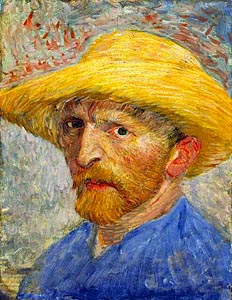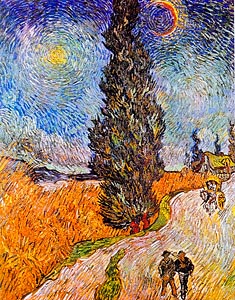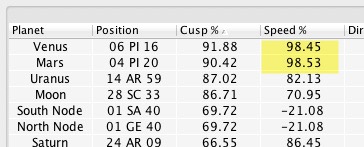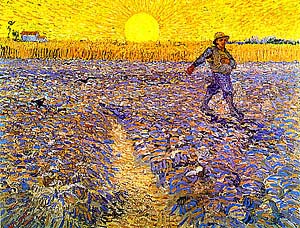Astrology, Kriya Yoga, Dharma
 One of the most famous painters of all time, Vincent Van Gogh combined brilliant colors and scintillating brush strokes. His horoscope shows theses forces at work: intensity and beauty, Mars and Venus, Fire and Water.
One of the most famous painters of all time, Vincent Van Gogh combined brilliant colors and scintillating brush strokes. His horoscope shows theses forces at work: intensity and beauty, Mars and Venus, Fire and Water.
Van Gogh's nativity has the watery sign Cancer rising. With no planets in the first house itself, we therefore look to the constellation Cancer and its ruler the Moon (see Chapter X), to tell us the most about Van Gogh. His Moon is in the sign Scorpio - the sign where the Moon has the lowest Essential Dignity. It is harmed by close conjunction from the South Node and an applying square to Mars... a challenge !
The ancients considered the Moon to be best placed in fruitful and pacific Taurus. They considered it most poorly disposed in Scorpio. One of the keywords for Scorpio is intensity. Scorpio Moon brings extremes of feeling: the highest highs and the lowest lows. If Van Gogh's paintings are anything, they are... intense.
Yes, they are paintings of commonplace scenes and common folk, but they are almost psychedelic in their vividness. It has been speculated that Van Gogh suffered from a mental disorder. In Ayurveda, we see the classic pattern of of a Pitta imbalance. When the Lord of the chart is in a sign ruled by Mars, it's no surprise to see red hair and ruddy features.
When Fire is excessive in the chart, Pitta accumulates over time. When it affects the mind, one starts to burn the candle at both ends. People with extreme Fire burn brightly and quickly. His paintings are those of a man on fire. From an astrological perspective, Van Gogh burned up.
For charts with Cancer rising, Jupiter can function as a highly spiritual symbol because it rules Pisces the 9th house. In Van Gogh's chart, it's found in the 6th house in it's own sign, Sagittarius. That makes it a doubly Jupiterian, doubly spiritual symbol, located in the house devoted to perfectionism and unselfish service. Detail work. Purification of the soul through hard labor. What the ancients called Orum et Laborum: Prayer and Work. One of Van Gogh's early callings, was to preach the Gospel. The Son of a minister, he studied Theology. He became an evangelist and preached in an impoverished coal-mining region. Like the saints of old, he lived in poverty and simplicity - sleeping on a straw mat in a hut.
Van Gogh started painting only in his late twenties - and worked for only a decade. Most of his greatest paintings are from the last two years of his short lifetime. Towards the end, he just seemed to bang them out. Like Mozart - another short lived genius - he was a "worker". Like Mozart, he had an afflicted Moon. (See Chapter VIII for more on Mozart)
 Van Gogh's Moon is close to Ketu, the South Node. That's a negative influence too - for worldly affairs: Ketu is "other-worldly". It promotes solitude and independent thinking. It's not a wealth symbol: one gives away what one has and lives off the beneficence of others. From a more spiritual perspective, it's a wonderful influence. It makes one a mystic, a recluse, a poet, a sensitive soul among the barbarians. Ketu is like Neptune. Van Gogh studied to be a minister, lived alone, contemplated Beauty and made paintings.
Van Gogh's Moon is close to Ketu, the South Node. That's a negative influence too - for worldly affairs: Ketu is "other-worldly". It promotes solitude and independent thinking. It's not a wealth symbol: one gives away what one has and lives off the beneficence of others. From a more spiritual perspective, it's a wonderful influence. It makes one a mystic, a recluse, a poet, a sensitive soul among the barbarians. Ketu is like Neptune. Van Gogh studied to be a minister, lived alone, contemplated Beauty and made paintings.
When the ruler of the chart is afflicted, we can expect a shortened life span. Van Gogh died at the age of 37.
Van Gogh lived like a monk and was familiar with Buddhism and Japanese painting. According to Daniel Tso (Van Gogh & Buddhism)
When the ruler of the chart conjuncts Jupiter - as it does in Van Gogh's chart - one becomes a traveller, a seeker. "Don't fence me in" is the watchword. Freedom and Liberty are highly cherished. When Jupiter is in its own sign, Sagittarius, it's just more of same. A strong influence of Jupiter brings one to the ministry - but it's also a classic indication of climbers, explorers and outdoorsmen. It's a great pattern if you want to be a landscape painter !
According to The Astrologer's Handbook by Sakoian and Acker, Jupiter in Sagittarius
 Venus is powerful in this chart: it's exalted in Pisces, in the 9th or best house in the chart. Isn't that what we would expect, in the chart of one of the world's greatest painters ? If we didn't see such a strong Venus, we would have to question the validity of the chart, the birth date and time. Venus is the planet of fine arts. In Pisces, it becomes the symbol of painters, musicians and poets.
Venus is powerful in this chart: it's exalted in Pisces, in the 9th or best house in the chart. Isn't that what we would expect, in the chart of one of the world's greatest painters ? If we didn't see such a strong Venus, we would have to question the validity of the chart, the birth date and time. Venus is the planet of fine arts. In Pisces, it becomes the symbol of painters, musicians and poets.
At the time of birth, Van Gogh's Mars was moving very fast at 99% of its possible forward velocity. Planets are said to flourish in the angular houses: I, IV, VII and X. Mars is therefore very strong. Van Gogh's Venus was moving at 99% forward speed. Heavens !
Venus and Mars. Mars and Venus. In Pisces. This accounts for the drama, vividness and imagination in his paintings - and in everything he did. It's called Passion.
Most people have what we call the "splash" pattern: a few planets here, a few there: a fairly even distribution. That's because most people have a broad range of interests and an average intensity of Karma. Not so with Van Gogh.
All the planets in Van Gogh's chart are contained within one half of the chart. We call this the "bowl" pattern and it means something special: intensity. Sound familiar ? We already pointed out that his chart contains many converging layers of symbolism, which indicate intensity. Here's another one !
The bowl chart is like a parabolic reflector: it brings focus to whatever is at the center of the bowl. In this case, Venus and Mars are at the focal point. They are in direct square aspect to the North and South Nodes. This further emphasizes the Venus/Mars combination in Van Gogh's chart. The focus of the bowl is at the Midheaven: still more emphasis on those symbols. Ouch !
As we have pointed out in other articles, the North Node/South Node axis is a powerful force. When it transits over a sensitive portion of the chart - or when it moves there by Symbolic Direction - real changes are seen in the life of the native, in the houses where the axis is placed.
In Indian astrology, there is a special Yoga or pattern for charts where all the planets are located on one side of the nodal axis: Kala Sarpa ("Serpent of Time"). It is a pattern of hardship, in the houses where the axis is placed and especially in the house with higher longitude (the later sign). In Van Gogh's chart, the axis goes from Gemini to Sagittarius, from the Twelfth house to the Sixth House. These are the places where Van Gogh's chart was most challenging: solitude and spirituality (the Twelfth House), health and work (the Sixth House).
To be technically correct, Van Gogh doesn't have an exact Kala Sarpa Yoga - because the Moon is on the other side of the Nodal axis. However, this author thinks it may be present just the same. The focus of the Kala Sarpa Yoga is Ketu and the Moon in the Sixth House. Ketu is considered very strong in Scorpio and it harms the Moon, which as chart ruler is the primary symbol of health and identity.
 From the perspective of traditional medicine, Van Gogh's paintings show what it's like to have powerful excess of the Fire element. His Moon is in Scorpio, which while a water sign, is ruled by Mars and Pluto, the fiery planets.
From the perspective of traditional medicine, Van Gogh's paintings show what it's like to have powerful excess of the Fire element. His Moon is in Scorpio, which while a water sign, is ruled by Mars and Pluto, the fiery planets.
His Jupiter and Ketu are in Sagittarius, a Fire sign. His Moon - lord of the chart - is conjunct that Jupiter. Van Gogh also has 4 planets in Aries - bringing the total number of Fire planets to 6 out of 12. That's 50%. That's an extreme Fire emphasis.
When Venus combines with Mars, one's artistic style is Fiery: strong colors, bright colors, warm colors. Saturated colors. Strong lines, strong composition. Intense feeling. Sunshine blasting off the canvas. Moonlight so blue, you can practically taste it. Portraits like X-Ray images. Landscapes that shimmer and scintillate.
 Traditional Indian astrologers like to make predictions. They are less interested in psychology and more interested in foretelling the facts of a person's life. One of the most basic facts, is length of life, called Ayurdaya in Sanskrit. Why make a prediction about someone's old age, if we see that their life will be of only middle or short duration ?
Traditional Indian astrologers like to make predictions. They are less interested in psychology and more interested in foretelling the facts of a person's life. One of the most basic facts, is length of life, called Ayurdaya in Sanskrit. Why make a prediction about someone's old age, if we see that their life will be of only middle or short duration ?
Van Gogh died at age 37 of a gunshot wound. Note that there are 37 degrees of longitude between his Sun and his Saturn. At age 37, his directed Sun (one degree per year) crossed over his natal Saturn. His was a Saturn fallen in Aries. Saturn, the prime malefic symbol. Saturn, lord of the Eighth House of death. Any astrologer could have seen that aspect coming - and known about the dangers. It's simple arithmetic.
Van Gogh left Paris and moved to Arles in Feb 1888, just after his Moon Dasha started. Given the status of his Moon, his days were numbered. A traditional Indian priest or astrologer, drawing up the Dashas soon after Van Gogh's birth, would have been alert to this period. In southern France Van Gogh found suitable surroundings (Moon) for his work. He flourished artistically - but developed gravely serious problems affecting his mental and physical fitness. When the Dasha of an afflicted chart lord arrives, health problems are never too far away. When the Dasha of that planet comes along, the Karma bears fruit.
At the time of his death, Van Gogh was running the Vimshottari Dasha of Moon/Rahu. This was the "trigger". We've pointed out that Van Gogh's Moon and Rahu are in close opposition and that Van Gogh's Moon is badly afflicted by proximity to a powerful Ketu. A Moon/Rahu "complex" or Yoga is often seen in charts of people with exceptional mental problems: Jim Jones and Adolph Hitler for example. They took their own lives. Whether Van Gogh took his life, is a matter of some controversy.
Not all incarnations are easy. Genius often comes at great price. Many great artists suffer through extremes and are nevertheless able to channel Divine Inspiration through their art. The vicissitudes of life help them focus on their goal.
Millions and millions of people have enjoyed and appreciated Van Gogh's paintings. Reproductions hang on walls over the world. People stand in lines for hours to see them in person.
Spirituality is more than self-sacrifice and self-discipline. It is more than prayers and worship, study and piety. Those are important - the foundation - but they are not the end goal. Some souls share words and teachings. Some teach through meditative silence. Others, like Van Gogh, share what they see. That is their Seva - their spiritual service.
 Interested in the horoscopes of other artists and musicians ?
Interested in the horoscopes of other artists and musicians ?
See these articles:
 Want to learn more about Astrology ?
Want to learn more about Astrology ?
See these authors: